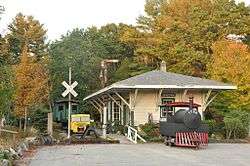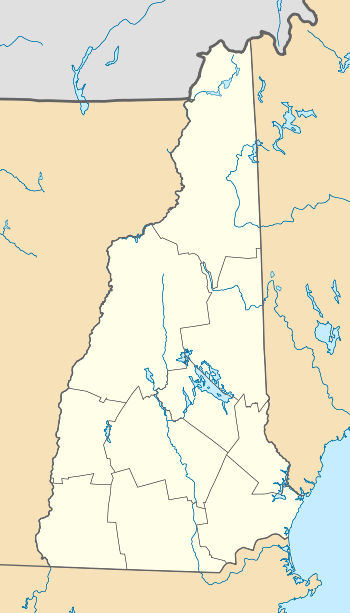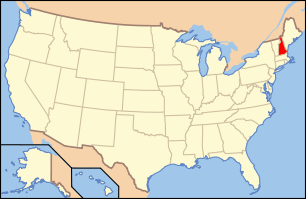Sandown Depot
The Sandown Depot is a former railroad station of the Boston and Maine Railroad in Sandown, New Hampshire. Built in 1873-74, it is the best-preserved of stations built by the Nashua and Rochester Railroad to survive, remaining relatively unaltered since its construction, and still at its original location. It is now a local history museum, and was listed on the National Register of Historic Places in 1986.[1]
Sandown Depot, Boston and Maine Railroad | |
 | |
  | |
| Location | Depot Rd., Sandown, New Hampshire |
|---|---|
| Coordinates | 42°55′46″N 71°11′8″W |
| Area | less than one acre |
| Built | 1873 |
| NRHP reference No. | 86002167[1] |
| Added to NRHP | September 4, 1986 |
Description and history
The former Sandown Depot is located on the north side of the village center of Sandown, just off Main Street between Depot Road and the former railroad right-of-way now occupied by the Rockingham Recreational Trail. It is a single-story wood frame structure, measuring about 20 by 50 feet (6.1 m × 15.2 m). Its exterior is finished in wooden clapboards, and it is covered by a broad low-pitch hip roof, whose eaves extend well beyond the structure and are supported by large knee brackets. The track side of the building has a projecting window bay near the center, next to which a semaphore mast rises through the roof. The interior is divided into sections historically used as passenger waiting areas (one each for men and women), freight storage, and the station master's office and telegraph dispatch. Portions of the interior have been modernized.[2]
This station was built in 1873-74 by the Nashua and Rochester Railroad, which was eventually absorbed by the Boston and Maine. The station was a major location on a heavily traveled single track, with support services including a telegraph office, post office, freight depot, and a large siding area with capacity for 62 cars. It consequently became a major point of civic activity in the rural town. Rail traffic declined in the early 1930s, and the rails were taken up in 1935. The depot building was used by the state highway department as a storage facility between 1934 and 1977, and has since been converted to a local history museum.[2]
References
- "National Register Information System". National Register of Historic Places. National Park Service. July 9, 2010.
- "NRHP nomination for Sandown Depot, Boston and Maine Railroad". National Park Service. Retrieved 2014-07-18.
External links
- Sandown Historical Society - Facebook site
- Sandown NH Depot Website - web site
